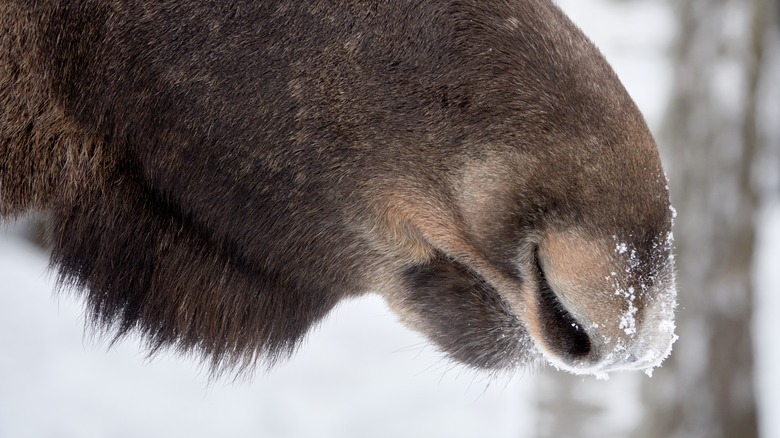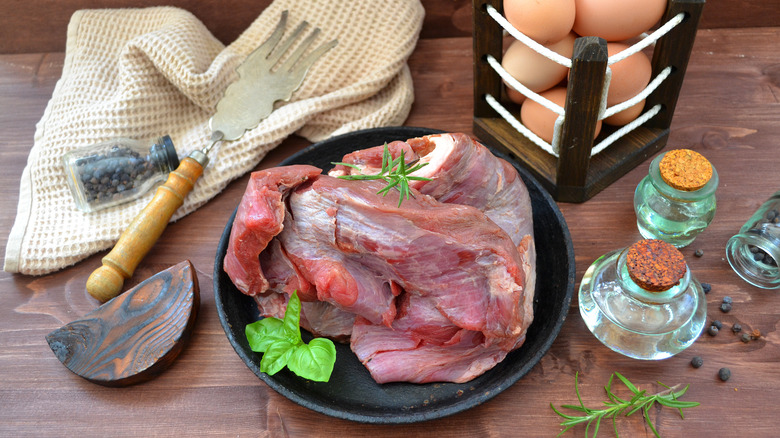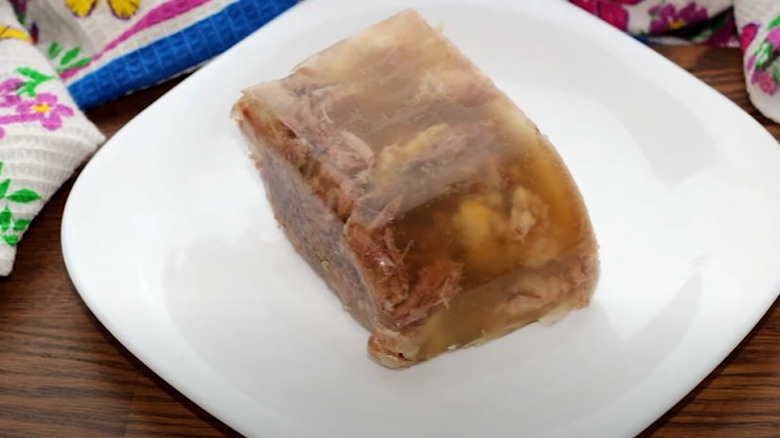Jellied Moose Nose Is A Delicacy In Some Canadian Indigenous Communities
For those outside of Canada, jellied moose nose might sound unconventional, but it turns out, it's counted among the world's unexpectedly great delicacies. As a matter of fact, the general use of non-muscular variety meats (aka offal) is as old as the invention of cooking itself, according to the Encyclopedia Britannica. In Western diets, this includes beef, mutton, and pork, whether it be blood, feet, heart, kidney, or liver specifically. Eating offal dishes like black pudding, chitterlings, and sausage can provide one with plenty of minerals, protein, and vitamins, and it can also help ensure that very little of an animal goes to waste.
This culinary tradition often includes the head of an animal, also, sometimes the brain or tongue in particular. There's one dish that's rather similar to jellied moose nose, per Atlas Obscura, called head cheese. Also known as souse, it uses a hog's head — with the brain, hair, eyes, and skull removed — to make a flavorful collagen full of herbs and spices (via the American Culinary Federation). This resembles pâté or French terrine and is served cold with bread or crackers. However, there are other animals besides pigs with which this sort of thing can be accomplished.
Moose makes for a meaty mouthful
In addition to classics like pork, mutton, and beef, some people also eat moose. These arctic, vegetarian, herd mammals are the biggest species of deer, standing over six feet tall and weighing in at almost 2,000 pounds, per National Geographic, so there's plenty of meat on their bones. They're also of "least concern" for extinction, which means you don't need to feel guilty about eating them from a conservation standpoint. The most distinguishing feature of a moose, aside from its wide antlers, is probably the long face with its protruding muzzle.
However, most meat lovers are typically more interested in the moose's body. According to Outdoor Canada, after removing the fur, guts, and hooves, a hunter will still be left with hundreds of pounds of edible moose ready to be butchered. Then, there are all sorts of tasty dishes, such as sausages or stews, that one can make with a moose's brisket, flank, hips, ribs, sirloin, and more, even if moose is admittedly a bit chewy and gamey. People also occasionally eat the bone marrow, heart, kidneys, liver, tongue, and nose of a moose.
This dish passes the smell test
How does one prepare a moose nose? Per Atlas Obscura, the fur is removed, then both the white and dark meat gets sliced up and cooked alongside spices. Some chefs also add in other moose head parts, like lips and ears. Next, the mix is left out to cool before being laid into a meatloaf pan doused with broth. Lastly, refrigeration solidifies it all together. The final product is a textured jelly that's sometimes served with bread. Many indigenous cultures in northwest Canada have long considered jellied moose nose a delicacy, and it was also featured as a recipe inside a Canadian government cookbook circa 1967, which helped those living in the wilderness feed themselves.
Folks still eat the dish in the 21st century, too. Celebrity chef Andrew Zimmern believes it's important to eat "bizarre" foods and demystify them, so naturally, he once tried jellied moose nose on his aptly named show, Bizarre Foods (via Discovery Plus). In Anchorage, Alaska, the host visited a processing facility where moose is prepared, then tasted the nasal dish, declaring it a true delight. "With the pickling spices in there, you get that great sort of, like, corned beef flavor," he elaborated. "You just explode through all these little tastes." He's not alone in this assessment. Some indigenous communities like the Gwich'in still eat the treat, too, as documented by the CBC. So, while it may not be the most mainstream food, it's certainly a local favorite.


